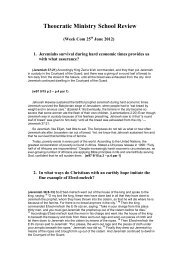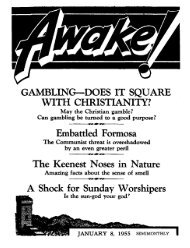1964 Awake! - Theocratic Collector.com
1964 Awake! - Theocratic Collector.com
1964 Awake! - Theocratic Collector.com
Create successful ePaper yourself
Turn your PDF publications into a flip-book with our unique Google optimized e-Paper software.
the thought-conveying medium of the engineer<br />
to his employee on the' "big ditch"<br />
project. It had been a contributing factor<br />
to many an old-timer's staying on the payroll.<br />
But this third generation was receiving<br />
more and more of its education in now<br />
well-organized Panamanian schools, where<br />
Spanish was the language. Language lethargy<br />
must yield to a live interest in and<br />
knowledge of the tongue of the country.<br />
Another thing-the citizenship of this<br />
generation, long overdue for settlement,<br />
was inevitably interlaced with the language<br />
change. Many were adopting the citizenship<br />
of their ancestors. Others attending<br />
Panamanian schools felt thoroughly Panamanian,<br />
taking that citizenship very seriously.<br />
For all those declaring Panamanian<br />
citizenship the learning of Spanish was<br />
a must. In 1954 the plan was conceived<br />
of transforming the erstwhile local-rate<br />
schools into Latin-American schools, with<br />
all classes to be taught in Spanish, thus<br />
accentuating an educational orientation to<br />
the country of Panama.<br />
As reported in the newspaper Star and<br />
Herald, Panama, R.P., of March 19, 1954,<br />
the then Canal Zone governor, John S.<br />
Seybold, in an address to Panama Rotary<br />
Club on 'problems that directly or indirectly<br />
concern Panama,' said, in part: "We<br />
must orient this student (of the local-rate<br />
schools) to his future ... The product of<br />
our present school system is ill-fitted to<br />
find employment equal to his norm of possible<br />
attainments .... To remedy this the<br />
group should receive in our schools the<br />
curriculum and training of the schools of<br />
the Republic with secondary emphasis on<br />
the teaching of the English language ....<br />
These Latin-American schools, as they will<br />
be redesignated, will be replaced ... on a<br />
<strong>com</strong>pletely Spanish-language basis ... The<br />
study of the English language will of<br />
course be continued throughout ... Span-<br />
22<br />
ish will be' taught in every grade of the<br />
school Wlits attended by U.S. citizens."<br />
This suggested changeover was <strong>com</strong>plete<br />
by the school year of 1956-57, and its impetus<br />
has been added to the tremendous<br />
change already being effected linguistically.<br />
This present generation, although it<br />
may know English, may speak it at home,<br />
may use it at will, is definitely oriented to<br />
think in Spanish.<br />
Looking at the situation statistically, another<br />
clear reason arises for this change<br />
of scene. Whereas in 1911, the year of<br />
Panama's first 'count of noses,' 11.6 percent<br />
of those noses represented a foreignborn<br />
population residing in the Republic,<br />
two decades later the percentage was<br />
slightly lower, registered as 10.1 percent.<br />
In 1950 the decrease was more pronounced<br />
-only 6.2 percent. And the last census,<br />
taken in 1960, showed only 4.2 percent.<br />
This calculation on a percentage of population<br />
basis still does not present the whole<br />
story, for the census report shows that<br />
from 1911 to 1940 there was actually an<br />
increase from 38,972 to 50,713 in the number<br />
of individuals constituting this foreignborn,<br />
population. From then until 1960 this<br />
number decreased to 44,978. To be sure,<br />
at no time were all these individuals<br />
English-speaking, though the majority<br />
were; and certainly not all of those were<br />
of West-Indies extraction.<br />
Among those of this latter mentioned<br />
group, the decrease in their numbers has<br />
approximated 5,500 during each of the<br />
past two decades, leaving their number today<br />
at about 11,000. Death's toll of some<br />
of them and the return of others to their<br />
native COWltry after their retirement on<br />
disability allowance at the age of sixty-two<br />
accounts for their decrease. Worthy of<br />
mention, too, in connection with the chang.<br />
ing scene, is the fact that many of the<br />
second and third generation stemming<br />
AWAKEI




